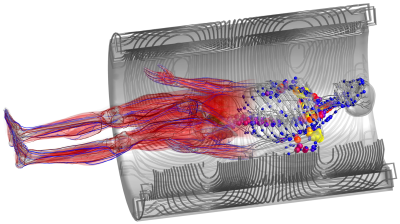Modeling Tissue Interactions with Gradients and RF Fields
Mathias Davids1
1Martinos Center for Biomedical Imaging, Germany
1Martinos Center for Biomedical Imaging, Germany
Synopsis
The time-varying magnetic fields used in MRI induce electric fields (E-fields) in the human body that can have adverse effects. The radio-frequency (RF) coils induce high-frequency (MHz range) E-fields that cause tissue heating and potentially irreversible tissue damage in the conductive tissue (SAR). The gradient coils induce low-frequency (kHz range) E-fields that can stimulate peripheral nerves (PNS), leading to involuntary muscle contraction of touch perception. Understanding SAR and PNS effects is important to allow developing mitigation strategies to overcome their impact on image acquisition, such as reduced excitation fidelity, longer scan times, and reduced spatiotemporal image resolution.
Introduction
The time-varying magnetic fields used in MRI for the image generation process induce electric fields (E-fields) in the human body that can have adverse effects. The radio-frequency (RF) coils induce high-frequency (MHz range) E-fields that cause tissue heating (and potentially irreversible tissue damage) in the conductive tissue. The amount of energy deposited in the body is referred to as SAR (Specific Absorption Rate). The gradient coils induce low-frequency (kHz range) E-fields that can stimulate peripheral nerves (PNS), leading to involuntary muscle contraction of touch perception.Both SAR and PNS limit what we can achieve in MR imaging: SAR limits the excitation fidelity and leads to longer sequence durations; PNS reduces the spatiotemporal image resolution and leads to longer echo-times. Understanding both effects is important to allow developing mitigation strategies to overcome these limitations.
Content
In this educational session, we will give an introduction to the physical and biological basics of SAR and PNS, and we will discuss established and novel strategies on how to deal with these adverse effects.Basics of electromagnetic modeling:
- Maxwell's equations
- High-frequency and low-frequency formulations
- Finite Difference Time Domain (FDTD) and Finite Element Method (FEM)
- Example of solving LF fields in simple models
- Physical basics
- Mitigation using SAR-constrained RF pulse design
- Overview of other mitigation methods
- Physical and biological basics
- Action potential initiation and propagation
- Interactions between nerves and E-fields
- Full modeling of nerve ion dynamics
- PNS mitigation using PNS optimized gradient coil layouts
